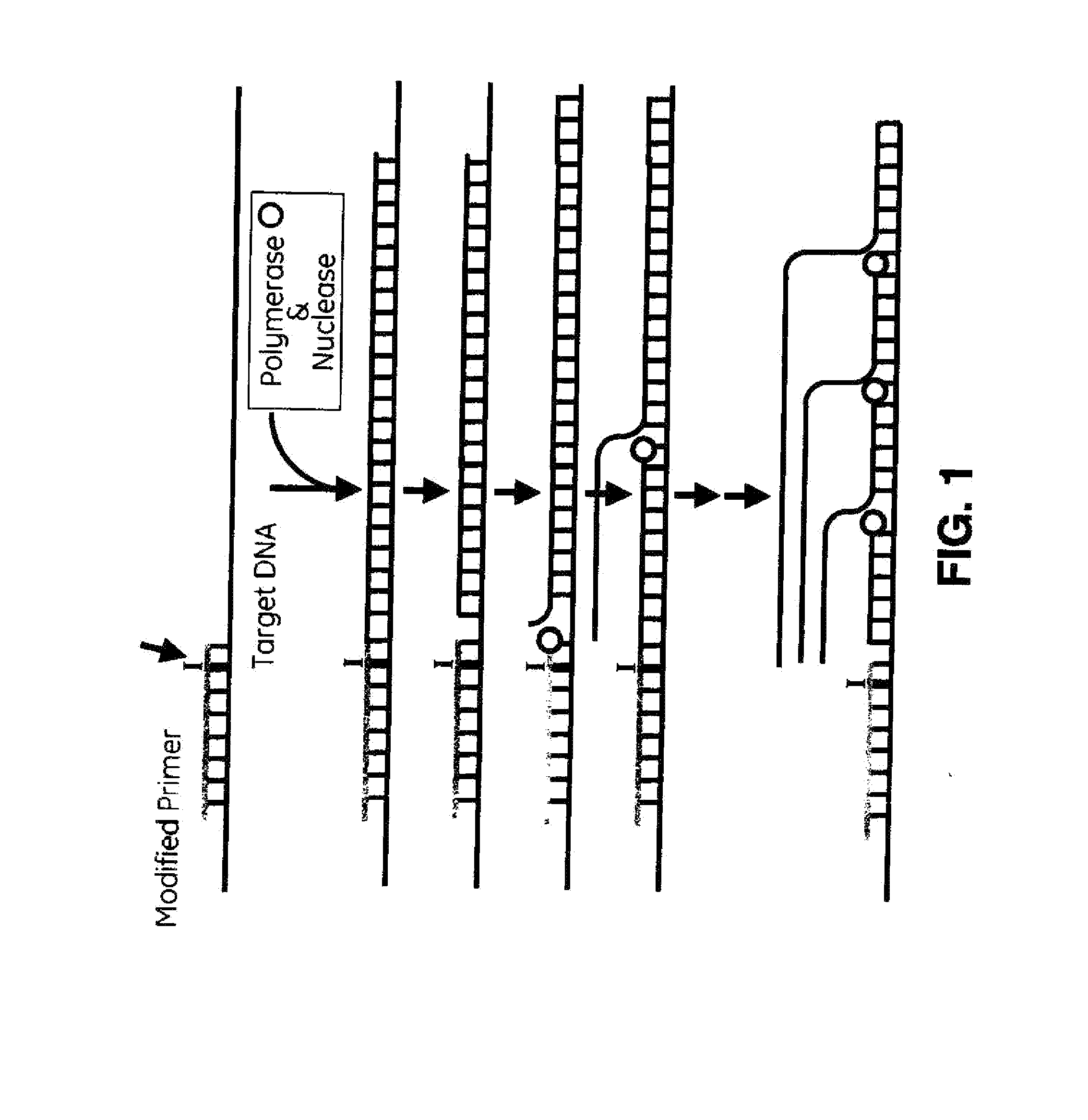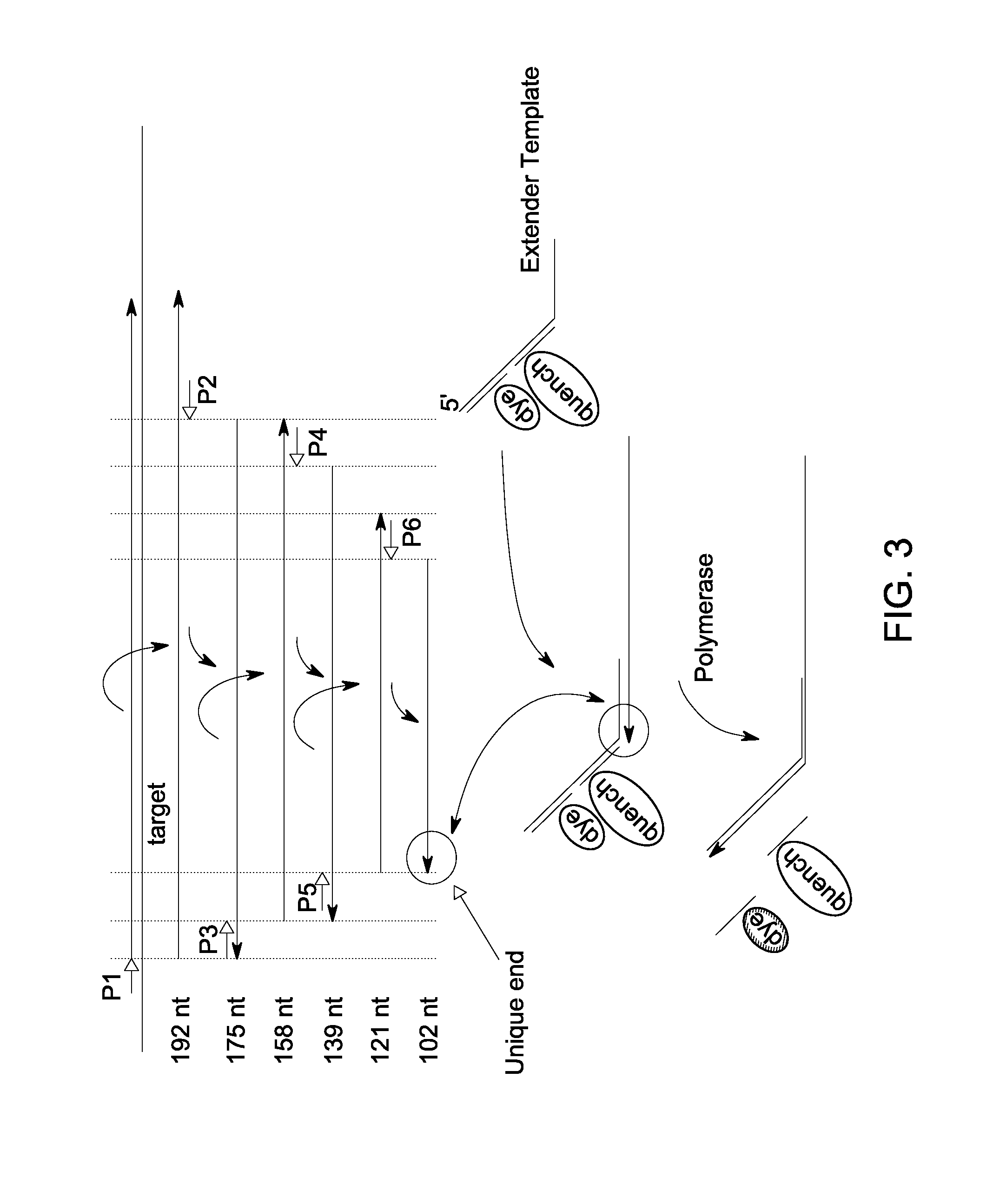Mutant endonuclease v enzymes and applications thereof
a technology of endonuclease and mutant enzymes, applied in the field of mutant endonuclease v mutant enzymes, can solve the problems of high background signal of dna amplification, wrong diagnosis, and even more problematic background amplification reactions
- Summary
- Abstract
- Description
- Claims
- Application Information
AI Technical Summary
Benefits of technology
Problems solved by technology
Method used
Image
Examples
example 1
Preparation of a PCR Product from the B. cereus Genomic DNA that is Used as Template for Amplification Reactions (Hereinafter, this PCR Product is Referred as “DNAG5”)
[0092]Bacillus cereus (B. Cereus) strain 15816 from American Type Culture Collection (ATCC, Manassas, Va.) was grown according to the supplier's recommendations. A lyophilized culture of B. cereus was re-suspended in 400 μL of Nutrient Broth then transferred to 5.6 mL of Nutrient Broth and incubated overnight at 30° C. with shaking. The Genomic DNA (gDNA) was isolated from the overnight liquid culture using MasterPure™ Gram Positive DNA Purification Kit (Epicentre® Biotechnologies, #GP1-60303) according to the manufacturer's instructions.
[0093]4×1.0 mL of overnight culture was pelleted by centrifugation in separate 1.5 mL tubes. Each pellet was resuspended in 100 μL TE Buffer by vortexing vigorously and added to separate 0.65 ml tubes. The 1.5 mL tubes were rinsed with 50 μL each TE Buffer and the wash were combined wi...
example 2
DNA Amplification Employing Various Polymerases, Single Primer and Two Primers
[0096]Exo (−) T7 DNA polymerase (Sequenase), exo(−) Bst polymerase (Bst large fragment) and exo (−) Klenow fragment were compared according to the reaction scheme presented below in Table 5 (volumes are indicated in microliters). P-1 corresponds to SEQ ID NO: 5 and P2-1 corresponds to SEQ ID NO: 6. Reactions 1, 2, 7, and 8 containing the exo (−) Bst polymerase were incubated at 43° C. for 3 hours. The remaining reactions containing exo (−) Klenow or T7 Sequenase were incubated at 37° C. for 3 hours. Following storage at −20° C., the reactions were run on a 15% acrylamide (Invitrogen), 7M-urea gel. The results are shown in FIG. 4, wherein the 61′-mer and 45′-mer depicts the expected products. The “Ping product” was generated in almost all reactions. A small amount of both “Ping product” and the “Pong product” was generated by Bst polymerase, whereas a large amount of both “Ping product” and the “Pong produc...
example 3
Multiple Sets of Primers and Single Strand Binding Protein
[0097]4, 6, and 12 mixes of primers were combined as shown below in Tables 6-13. The primer mixes were prepared so that one addition would add 10 pmol [final concentration] of each oligos to the reaction mixture.
[0098]12 Mix:
TABLE 6Oligo P-1P2-11275129413131333137814821517153415601579
[0099]6 Mix:
TABLE 7Oligo P-1P2-11333137814821517
[0100]4 Mix:
TABLE 8Oligo P-1P2-113781482
[0101]Internal 4 Mix: The term “internal” represents that these primers were internal to the other primers used in other reactions:
TABLE 9Oligo1354 (645 pmol / uL)1333 (681 pmol / uL)1498 (732 pmol / uL)1517 (671 pmol / uL)
[0102]Reaction Scheme: DNAG5 was diluted 1:100 in TE buffer. 10× HEMT buffer includes 100 mM HEPES (pH 8), 1 mM EDTA, 0.1% Tween 20, and 30 mM MgCl2.
TABLE 10IDComponent123456789101112DNAG5 1:100−−−−−−−+++++12 mix+−−−−−−+−−−−6 mix−+−−−−−−+−−−4 mix−−+−−++−−+−−Internal 4 Mix−−−++++−−−++SSB, 1 μg / uL+−−+−+−+−−+−SSB, 10 ng / uL−++−+−+−++−+1354−−−−−−−−−−−−(1...
PUM
| Property | Measurement | Unit |
|---|---|---|
| Efficiency | aaaaa | aaaaa |
Abstract
Description
Claims
Application Information
 Login to view more
Login to view more - R&D Engineer
- R&D Manager
- IP Professional
- Industry Leading Data Capabilities
- Powerful AI technology
- Patent DNA Extraction
Browse by: Latest US Patents, China's latest patents, Technical Efficacy Thesaurus, Application Domain, Technology Topic.
© 2024 PatSnap. All rights reserved.Legal|Privacy policy|Modern Slavery Act Transparency Statement|Sitemap



